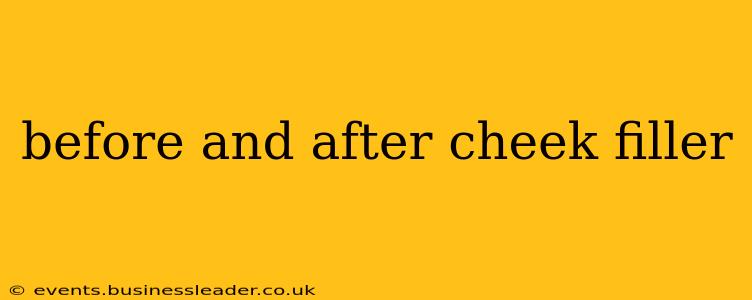Cheek filler injections have become increasingly popular as a non-surgical way to enhance facial features and achieve a more youthful appearance. Understanding what to expect before, during, and after the procedure is crucial for making an informed decision and ensuring optimal results. This comprehensive guide will explore everything you need to know about cheek filler, from the initial consultation to the long-term effects.
What Happens Before Cheek Filler?
The journey to fuller cheeks begins with a thorough consultation with a qualified and experienced medical professional, such as a dermatologist, plastic surgeon, or a registered nurse injector. This initial meeting is paramount. Don't rush this crucial step.
What to Expect During Your Consultation:
- Medical History Review: The practitioner will review your complete medical history, including any allergies, current medications (both prescription and over-the-counter), and previous cosmetic procedures. This is vital to assess your suitability for the procedure and to mitigate potential risks.
- Facial Assessment: A detailed assessment of your facial structure, skin type, and desired outcome will be performed. Photographs will likely be taken to document your current appearance and to serve as a reference point for the treatment plan.
- Discussion of Expectations: Open and honest communication is key. Discuss your goals realistically with your practitioner. They will explain what is achievable and manage expectations to avoid disappointment. Bring photos of the desired outcome for clearer communication.
- Treatment Plan: Based on the assessment, a personalized treatment plan, including the type and amount of filler to be used, will be developed.
- Potential Risks and Side Effects: A comprehensive explanation of the potential risks and side effects, such as bruising, swelling, infection, and uneven results, will be provided. Informed consent is essential.
What Happens During Cheek Filler Injection?
The actual injection procedure is relatively quick and minimally invasive. It typically involves the following steps:
- Numbing: A topical anesthetic cream might be applied to numb the area before the injections.
- Injection: The practitioner will strategically inject the filler into specific areas of the cheeks to achieve the desired results. The injection process may feel a little uncomfortable, but it's generally well-tolerated.
- Post-Injection Assessment: After the injections, the practitioner will assess the results and make any necessary adjustments.
What Happens After Cheek Filler?
Post-procedure care is crucial for optimizing results and minimizing potential side effects.
What are the Common Side Effects After Cheek Filler?
- Swelling: Swelling is a common side effect, and it usually subsides within a few days to a week.
- Bruising: Bruising is also possible, and its severity can vary depending on the individual. Ice packs can help minimize bruising.
- Redness: Mild redness at the injection site is common and usually resolves quickly.
- Tenderness: Some tenderness to the touch is normal.
What is the Recovery Process Like?
Recovery from cheek fillers is usually straightforward. Most patients can resume their normal activities immediately. However, it's advisable to avoid strenuous activities and excessive sun exposure for a few days.
How Long Do the Results Last?
The longevity of cheek filler results varies depending on the type of filler used, the amount injected, and individual factors such as metabolism and lifestyle. Results typically last from 6 months to 2 years. Maintenance injections may be required to maintain the desired results.
How Much Does Cheek Filler Cost?
The cost of cheek filler can vary significantly depending on several factors, including the amount of filler used, the practitioner's fees, and the geographic location. It is best to contact your chosen practitioner for a personalized quote.
Is Cheek Filler Right for Me?
Cheek fillers can significantly enhance facial aesthetics, but it's essential to discuss your suitability with a medical professional. They will assess your individual needs and determine whether cheek fillers are the right choice for you.
Are There Alternatives to Cheek Filler?
Yes, there are alternative treatments for enhancing the cheeks, including surgical procedures like cheek implants and other non-surgical options like facial exercises and lifestyle changes. Discuss these alternatives with your practitioner during your consultation.
What are the Long-Term Effects of Cheek Filler?
With proper care and maintenance, cheek fillers offer a safe and effective way to enhance your appearance with generally long-lasting results. However, individual responses and the need for maintenance injections should be discussed with your doctor. Long-term side effects are uncommon with proper technique and selection of fillers.
This information is for educational purposes only and should not be considered medical advice. Always consult with a qualified medical professional before undergoing any cosmetic procedure. Choosing an experienced and reputable practitioner is critical to achieving safe and satisfactory results. Remember, realistic expectations are key to a positive experience.
